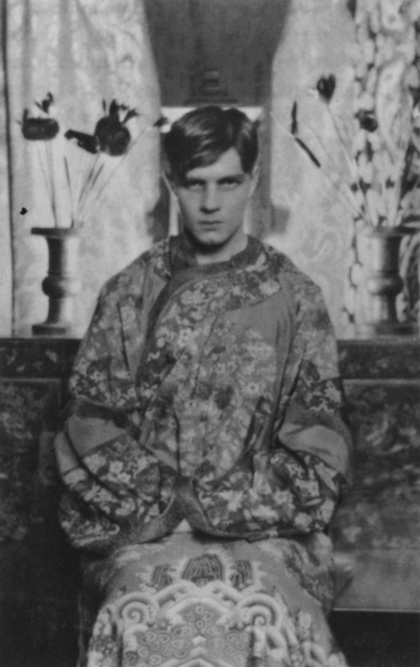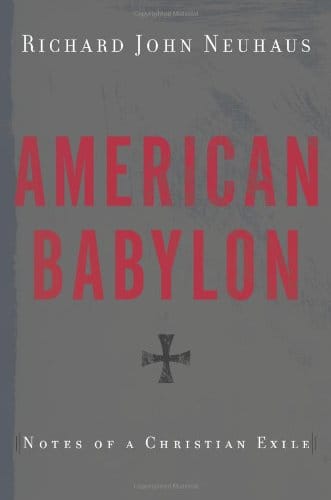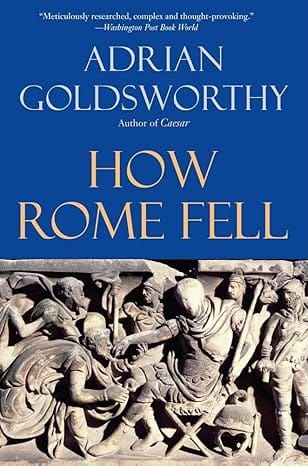The Long View: A History of the Crusades

Steven Runciman at Cambridge in 1925, photographed by Cecil Beaton
Sir Steven Runciman's three volume history has seen quite a bit of criticism in the last twenty-five years. However, it tells a hell of a good story, and you can learn something even if you disagree with Runciman's take.
A History of the Crusades
By Sir Steven Runciman
Cambridge University Press 1951-54
(Paperback 1990: ISBN 0 521 34770 X)
Volume I: The First Crusade and the Foundations of the Kingdom of Jerusalem (376 Pages)
Volume II: The Kingdom of Jerusalem and the Frankish East 1100-1187 (522 Pages)
Volume III: The Kingdom of Acre and the Later Crusades (528 Pages)
Sir Steven Runciman (1903-2000) was the Edwardian That Time Forgot. Perhaps the leading 20th-century authority on both the Crusades and on Byzantine civilization, he tells the tale of the former largely with an eye to vindicating the latter. The resulting assessment of the Crusading movement was thus somewhat harsh. The last sentence of this history runs: “High ideals were besmirched by cruelty and greed, enterprise and endurance by a blind and narrow self-righteousness; and the Holy War itself was nothing more than a long act of intolerance in the name of God, which is the sin against the Holy Ghost.” Gibbon, to whom Runciman was often compared, could not have coined a more telling anathema. What makes this a great history is that readers who do not accept that assessment will still find these volumes enjoyable and useful.
“A History of the Crusades” is chiefly a military and dynastic history. Large tracts of it are densely genealogical. This was unavoidable: the string of Crusader states along the Levantine coast, collectively called “Outremer,” were small, feudal, principalities, whose politics was the interaction of a few great families. Runciman sometimes discusses economics, but gives surprisingly little sustained attention to culture and religious history. In any case, the work rises above the details to reveal Outremer as an incident in the history of the Near East. Outremer was possible only during an era of shifting balance, from the 11th to the 13th century, between the Caliphate of Baghdad and the Byzantine Empire of Constantinople. When the balance was destroyed, by the Mongols and by the Crusaders themselves, Outremer soon fell, too.
Byzantium had actually recovered nicely from the explosive Islamic expansion of the seventh and eighth centuries. By the end of the first millennium, there was a reasonably stable international system in the Near East. Byzantium was the acknowledged protector of Orthodox Christians throughout the region. Constantinople was by far the largest city of Christendom. The Abbasid Caliphate of Baghdad, which represented Sunni orthodoxy, was becoming more venerable than powerful; the allegiance of the rulers of places like Mosul and Damascus was increasingly nominal. Meanwhile, the Fatimid Caliphate of Cairo continued on its own Shia course. Jerusalem was under its control, but Cairo encouraged the profitable flow of pilgrims and traders to the Holy Land. In the 11th century, however, the Seljuk Turks arrived from the east. They quickly revealed the fragility of the region.
The Turks were largely but not exclusively Sunni Muslim. They reduced the Caliphate of Baghdad to ceremonial significance. In the countries they conquered, their rulers adopted the Arabic word “sultan,” meaning “authority,” as the title for the holder of real political power. They went far west, sacking Jerusalem (only Christians were spared), but failed to conquer Egypt. Most important, they ended Byzantine control over most of Anatolia in 1071, at the Battle of Manzikert. That battle was the proximate cause of the Crusades.
The 11th century is also the time when the Latin, Roman Catholic Church of the West and the Greek, Orthodox Church of the East are usually said to have split. The Great Schism occurred in 1054, when the pope of Rome and the patriarch of Constantinople exchanged mutual anathemas. Runciman makes very clear, however, that neither side regarded the differences between the Latin and Greek churches as permanent until the 13th century, or even the 15th. In fact, it was during one of the partial reconciliations between Rome and Constantinople that the Emperor Alexius I asked Pope Urban II, almost as an afterthought, for Western assistance in driving back the new Muslim encroachments onto historically Byzantine territory. The idea was that this would again make it possible for Western pilgrims to visit Jerusalem safely.
Western warriors fighting for Byzantium were not a novelty. The emperor's own Varangian Guard of Englishman and Vikings is familiar to every student of history (and indeed to every student of the better comic strips). Companies of Frankish knights had long featured in the empire's armies. (At least in the beginning, most of the “franks” in the east were from what would become France, but the term later referred to any Westerner.) Alexis I would no doubt have been satisfied with one or two thousand extra mercenaries. What he got was a mass movement.
Urban II preached the First Crusade at Claremont in France, in 1095. The nobility and the laity jumped at the chance to free the Holy Places from the infidel. Runciman makes much of the idea that the Crusades appealed most to the younger sons of feudal lords, who otherwise could have looked forward only to lives as landless poor-relations. This idea has been questioned since; certainly the leaders of the First Crusade were among the most eminent men of their time. He also never quite comes to grips with why the crusading movement so appealed to ordinary people. He suggests that the average peasant may have confused the earthly Jerusalem with the heavenly one. Be this as it may, as long as the Crusade was a popular movement, it was liable to spark pogroms against the Jews in Europe. Before the Crusade proper even set out, rabbles of religious fanatics swarmed toward the east.
Not without a certain amount of pillage and rapine, the First Crusade arrived in the neighborhood of Constantinople in reasonably short order. The emperor tried, with mixed success, to extract promises from the Crusaders that any of the recently lost Byzantine territory they might recover would be returned to the empire. The Crusaders and the imperial army soon did recover big chunks of Anatolia and northern Syria. The Crusaders rather exceeded the emperor's expectations when they recaptured Antioch independently. To everyone's surprise but their own, the Crusaders took Jerusalem in 1099. It was not actually true that they slaughtered all the inhabitants (many were ransomed), but their introduction to the region was not such as to endear them to the locals.
Nonetheless, the Crusaders settled into the region quickly enough. They became participants in local politics, fighting with and against the Muslim powers. There was much intermarriage between the Crusaders and the local Christians, particularly the Armenians. Franks newly arrived from Europe, eager to fight the infidel, were often shocked by the Franks of Outremer, with their penchant for native dress and relative religious tolerance. The newcomers thought the Franks of Outremer became soft, and maybe they were right. Though the Franks of Outremer had their territorial ambitions, they were not keen to launch further Crusades of their own. They welcomed Crusades from Europe only when their own situation was desperate. Of the five major Crusades, only the First was completely successful. Only the first three were even directed to the Holy land.
According to Runciman, the real beginning of evils between the Latin and Greek Churches was the Crusader tendency to install Latin Rite bishops into sees that had once been occupied by Greeks. The filoque clause, which was the nominal theological difference between the Greek and Latin churches, was negotiable. The problem was that the Crusaders were sometimes not above deposing an existing Greek hierarchy and replacing it with Latin incumbents. Gradually, despite many compromises, this led to overlapping jurisdiction, bishops in exile, and finally the end of intercommunion between the two rites.
Outremer, during the brief life of the Kingdom of Jerusalem, was something of a fool's paradise. Runciman suggests that there may never have been more than 2,000 adult Frankish nobles, outside the military Orders that arose to defend Jerusalem. Jerusalem itself, for that matter, was a singularly bad place for a capital city. Far more durable was the string of coastal cities and forts, as far south as Jaffa or Ascalon, that owed some degree of allegiance to the King of Jerusalem. (Antioch, though a Crusader state, was nominally a vassal of Byzantium.) Nonetheless, the Kingdom was not without good points. Despite his antipathy, Runciman allows that it was a remarkably tolerant place. Oaths could be taken in its courts on the Bible, the Koran, or the Torah, as the witness chose. Indeed, the Kingdom was thick with law. The real power lay in a High Council, which was not quite either a parliament or a supreme court, where there was some representation for the bourgeoisie and the clergy, as well as the aristocracy. Runciman does note, however, that the only contribution of Outremer to civilization seems to have been its formidable military architecture; Frankish forts were designed with an eye to the fact their garrisons would be relatively small.
With its small population, exposed position, and threadbare economy, the Kingdom's survival rested on two conditions. The first was that the Sunni rulers of Damascus were scarcely on speaking terms with the Shia of Cairo. The other was that, despite the chronic friction between Outremer and the Byzantine Empire, the emperor probably would not have allowed the Kingdom of Jerusalem to be wholly overrun. The latter circumstance no longer applied after the Battle of Myriocephalum in 1176, in which the Byzantine army suffered a defeat at the hands of the Turks from which it never recovered. Meanwhile, the famous Kurdish leader, Saladin, eliminated the Fatimid Caliphate in a palace coup, and so united Damascus and Cairo under a Sunni dynasty. After a siege and negotiation, he accepted the surrender of Jerusalem in 1187.
Saladin might have gone on to destroy all of Outremer, but maybe he was not terribly eager. He needed Palestine to ensure communication between Syria and Egypt, but the Frankish ports had their uses. In any case, the Third Crusade soon arrived. (The Second, which occurred 40 years earlier, had been directed at Damascus; the less said the better.) The history of the Third Crusade makes the best story of the whole Crusading period. The conflict between Richard the Lion Heart of England and Saladin reads like a single combat. In any case, the result was that Outremer survived, with its capital at the port city of Acre. The Crusaders had to settle for access to Jerusalem, rather than actual possession. The second Outremer arguably made better sense than the first. It was more defensible. It also did not contain any provocative holy places. Maybe this was less important than we might think, though. One of the revelations of the last century of the life of Outremer was how little the powers of the Muslim world cared for Jerusalem as a religious site.
We see this point illustrated in the Fifth Crusade (we will get to the Fourth in a moment), which was launched against Egypt in 1217. The Crusade was supposed to take Cairo, and it petered out to a sad end. However, when it briefly seemed to have some chance of success, the sultan actually offered to give Jerusalem back to the Franks. In perhaps the oddest episode in the whole history of the Crusades, the Franks did get it back, in 1228, by negotiation rather than by war. The negotiator was the Holy Roman Emperor, Frederick II Hohenstaufen, who eventually ran out of excuses not to go on the Crusade he had long promised. Runciman presents him as an evil genius, half an easterner himself because of his upbringing in still partially Muslim Sicily. Be that as it may, he acted like no other newcomer from Europe ever had before. Relying purely on diplomacy, he acquired limited control of Jerusalem for the ruler of Acre, including an access route from the coast. He also acquired the title to the kingship of Acre for his own line, by marrying the princess with the best claim to the throne. She did produce an heir, dying soon thereafter. That line, as well as Frederick's provisions for Jerusalem, came to an end not much later. Still, Frederick's career in Outremer shows what you can accomplish in the Middle East, if you speak the relevant languages and are unburdened by scruples.
The second Outremer was also more commercially viable than the first, because it was becoming increasingly Italian. The Kingdom of Jerusalem was a vigorous feudal state in the Norman mold. The Kingdom of Acre, and the gaggle of tiny states it led, was more like Genoa or Pisa or Venice, whose quarrelsome citizens made up a larger and larger percentage of the inhabitants of Outremer's cities. Acre and Antioch, indeed, were governed by communes on the Italian model, though they also owed allegiance to feudal lords. The drawback to the Italianization of Outremer was that the whole Crusading movement was increasingly subservient to the interests and policies of the Italian maritime republics. The effects of their rivalries on the already fractious internal politics of Outremer was bad enough. More seriously, Italian influence also led to the greatest scandal of the whole Crusading era, the sack of Constantinople in 1204 by the Fourth Crusade.
Runciman claims that this atrocity set at naught the whole purpose of the Crusades, which was to defend Christendom against Islam. The Fourth Crusade, he says, so weakened Byzantium that it lost the ability to defend the Balkans from the Turks, thus leading to the sieges of Vienna in the 16th and 17th centuries. Well, maybe, but Byzantium was clearly in decline long before the sack. It had been losing commercial ground to the Italians in the eastern Mediterranean and the Black Sea for years. This was in part because the imperial government sold trading privileges for ready cash, but also because the trade routes of the world were shifting. Byzantium itself was losing population and territory in Asia Minor and the Balkans. It is not clear how much difference the Fourth Crusade really made.
We do know that the Venetians, with a pretender to the throne of Constantinople in tow, diverted the Crusade from its announced destination and seized the city by force and guile. (Runciman points out that the pope honestly thought the Crusade was headed to the Holy Land, though Eastern historians have claimed otherwise.) When the pretender proved unable or unwilling to pay the Crusaders the amount agreed for their services, they dispensed with him and his dynasty. They then began what must have been among the most remarkable three days of looting in human history. When they were finished, they created the Latin Empire of Constantinople, complete with a Latin patriarch instead of a Greek one.
The Fourth Crusade made Byzantium itself a Crusader state, but only briefly. The Latin Empire never controlled the Byzantine Empire's hinterland, where several successor states immediately sprang up. The Palaeologus Dynasty retook Constantinople in 1261 and reestablished the Byzantine Empire, but meanwhile the world had changed. The empire by then was just one of a number of Orthodox states, one with a great lineage but few resources. More important, the Islamic world had become a harsher place.
One of the impressions I took away from this history was that the legend of Prester John was essentially correct. The Mongols were not themselves predominantly Christian, but their neighbors and onetime overlords, the Kerait people of northeastern Asia, were Christians of the Nestorian variety. The Mongols absorbed the Kerait territory and leadership, as well as their script. Although the Mongol empire, at least in the beginning, made a point of religious tolerance, there was heavy Christian influence among the advisers of Genghis Khan. There was even more Christian influence on Hulagu, who conquered southwestern Asia and eventually became the Ilkhan of Persia.
In the 13th century, there was quite a lot of coming and going between the principal courts of Europe and those of the khans, all with an eye to coordinating an attack on Islam. European representatives to the Mongol capital at Karakorum were exasperated by the Mongol principle that there were no sovereign states in the world, only current and future vassals of the Great Khan. Nonetheless, encouraging words were exchanged. Rather more substantive talks took place with a Nestorian priest from Hulagu's court, who said Mass for Edward I of England and received communion from the hands of the pope himself.
None of this really came to much. The Franks of Outremer was actually more cautious about allying with the Mongols than were their cousins in Europe. It was the local Christians, the Armenians and the Georgians, who accompanied Hulagu when he destroyed Baghdad in 1258. Few world cities have been as thoroughly destroyed as Baghdad was. While they were at it, the Mongols slew the Caliph, who had surrendered to them, and ended the Abbasid Caliphate, along with the Old Regime of Islamic history. (That is the reviewer's phrase, by the way, not Runciman's.)
A shadowy line of Abbasids, whose legitimacy Runciman doubts, continued at Cairo for some centuries. This was merely for show, however. The new legitimacy in the Muslim world was passing to people like Baibars, the new sultan who came to power in Cairo at about the time of the Mongol disaster. A member of the Mameluk corps, and so technically a slave, he overthrew what was left of Saladin's genteel but decadent dynasty. He then set about creating a ruthless and rather intolerant order to the south and west of the new Turkic and Mongol powers. The destruction of Outremer was part of this process. There was none of the courtesy or moderation of Saladin's day. With some exceptions, the cities of Outremer were dismantled and the inhabitants killed or enslaved. Acre itself fell in 1291.
There were later campaigns, against Egypt or Anatolia or in the Balkans, that are dignified by the term “crusade.” The interesting thing is that it became harder and harder to organize crusades, even as the Ottoman threat from Islamic world began to crystallize. Runciman speculates about why. Though he does not use the term, one might say that the Crusade had become a Sorelian myth that had overstayed its welcome. Sorelian myths are not lies, or not necessarily lies. They are the justifications for which power is exercised. The Crusade had long been the reason that governments gave for raising taxes, or for making and breaking alliances, or sometimes just for a bit of piracy. Even when Crusades met with some success, the benefits were not the sort of thing for which one started a Holy War. People were still willing to fight for God and country. They just no longer saw a Crusade as the way to do it.
As we saw at the beginning of this review, Runciman's assessment of the Crusades is wholly negative. Quite aside from the question of religious tolerance, he disparages the secondary benefits that are often claimed for the Crusades. Outremer did little or nothing to facilitate contact between Islam and Christendom, he claims. There was fruitful contact during the Crusading era, but it happened in Sicily and Spain. Outremer itself produced advances in military engineering, but no new art. More to the point, it did not make Christendom any safer. Quite the opposite: by its assault on Byzantium, the Crusades left Europe open to invasion.
Runciman does allow that Outremer might have made a decisive difference, if it had cooperated with the Mongols. Though he restrains himself from elaborating the what-ifs, he hints that, in the 13th century, it might have been possible to end Islam as we know it. With some Western aid and encouragement, the Mongols might have become the ruling stratum all the way to Egypt. It is likely that they would have embraced some form of Christianity, then the religion of large minorities in the Muslim world, and in some places even majorities. Islam, with Baghdad in ruins and with Mecca and Medina soon to follow, might have shrunk to the status of the heterodox Christian churches of the Byzantine Empire. There are problems with this scenario, but not so many that it could not serve as the premise of a counterfactual novel.
More seriously, let me suggest that, if the Crusades did not do much good, they also did not do much harm. The Islamic world became a more desperate and dangerous place after the 13th century, but that was not the Crusaders' fault. Though Outremer never went entirely native, it was never regarded with holy horror by its Muslim or Byzantine neighbors. It was eccentric, but then eccentricity was normal in a part of the world where, for instance, the Assassin sect was a weighty international power. For the most part, Outremer seems to have offered more stable government, and indeed more just government, than the other societies of the region. It is even possible that the Crusades did contribute to the defense of Europe. Though the Byzantine Empire had reestablished a frontier after the Battle of Manzikert, it was a diminished frontier, one that would have left the ports of the Levant in hostile hands. Without the Crusades, Constantinople might have fallen far earlier than 1453, and more catastrophically than in 1204.
Considerations like these would not have impressed the men of the First Crusade, of course. They were on a mission from God. What God actually thinks of their enterprise has yet to be announced.
Copyright © 2003 by John J. Reilly
A History of the Crusades By Sir Steven Runciman



Comments ()